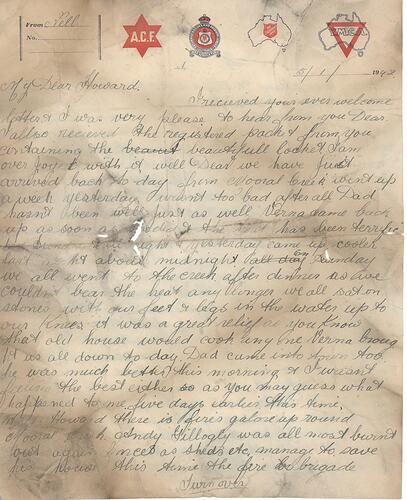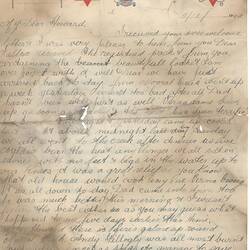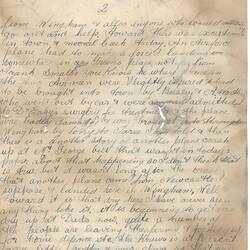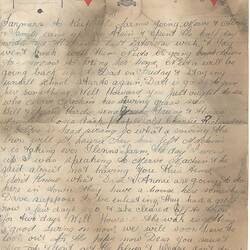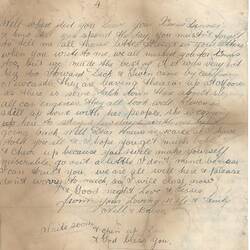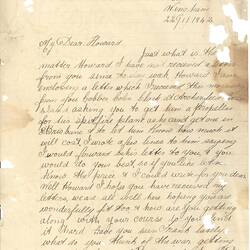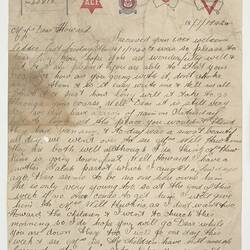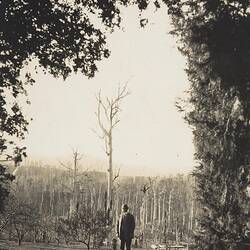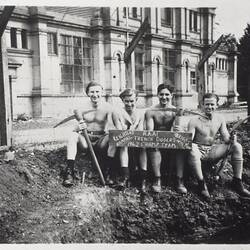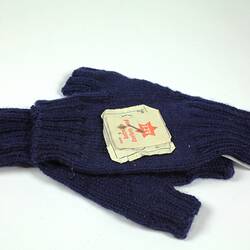Summary
Two-page letter to Howard from Nell, written on letterhead paper inscribed 'A.C.F., RSL, THE SALVATION ARMY, AND Y.M.C.A.' Nell thanks Howard for the locket. She has just returned home after a week with her father at Mooral Creek. The fires are bad around there. Andy Gillogly was almost burned out, but saved by Wingham Creek Fire Brigade. Last week an Air Force plane had to make a forced landing near Green's place not far from Frank Small's. The two airmen were injured and taken by car to town by Beesley and A. Worthing, and treated by Dr Erby. The plane was badly damaged and taken by lorry to Taree. Another plane had crashed up at Mt George. People are leaving their farms and joining up for Home Defence. Food is scarce, but they are asking farmers to keep the farms going. Merve, Alma and Family came up by train last week. They took Gay back with them but Neita will her back before school begins.... Signed Good night Love and kisses 'from your loving wife and family, Nell and Babes'. The letter is dated 5 January 1942.
The letter was found under the floorboards of the balcony level of the Gallery, Great Hall, Royal Exhibition Building, when replaced in 1989 as part of a restoration program. Many other items dating back to the 1940s were also found, providing an insight into the lifestyle and interests of RAAF personnel stationed in the building.
The letter was addressed to Howard Frederick Kellehear, service no. 60818 (his number appears at the top left of another letter from Nell). He enlisted in World War II in 9 September 1941 in Wingham, Sydney, at the age of 36, and attained the rank of Leading Aircraftman. He was discharged 13 March 1945.
The formal wartime occupation of the Exhibition Building began in October 1940, when it was requisitioned for the RAAF under the National Security (General) Regulations. Partitioning work began in January 1941, and on 15 March the RAAF no.1 School of Technical Training was moved to the Exhibition Building from West Melbourne Technical School. Before long the Great Hall and surrounding areas were crowded with Air Force personnel. About 500 to 700 men lived there for varying periods of time; numbers peaked in 1942, when about 2000 personnel were accommodated. The central part of the building was a mess hall. The arena was occupied by a kitchen, laundry blocks, a storeroom and a playing field. The southern and eastern sides of the building were used for parades and drilling. The RAAF remained in control of the Exhibition Building until October 1946. (David Dunstan,1996, Victorian Icon)
Physical Description
Two-page four-sided letter hand-written on lined paper. Four emblems in red and blue along top edge of letterhead: A.C.F., RSL, THE SALVATION ARMY, AND Y.M.C.A.
More Information
-
Collection Names
-
Collecting Areas
-
Acquisition Information
Transfer from Trustees of the Royal Exhibition Building (REB), Sep 1991
-
Place & Date Made
-
Addressed To
Howard F. Kellehear - Royal Australian Air Force (RAAF), Melbourne, Greater Melbourne, Victoria, Australia, 1942
-
Organisation Named
-
Organisation Named
-
Organisation Named
-
Organisation Named
South Australian Division, Australian Comforts Fund (ACF), Australia
-
Inscriptions
On letterhead: ACF / Returned Sailors and Soldiers League Victoria/ The Salvation Army / YMCA. Extensive handwritten text in black ink.
-
Classification
-
Category
-
Discipline
-
Type of item
-
Overall Dimensions
19.6 cm (Width), 24.7 cm (Height)
-
References
Information relating to the service record of Howard Kellehear is held in The World War Two Nominal Roll - [Link 1] (accessed 12/1/2009). His service records are held in the National Archives of Australia - Series accession number 2002/04835295, Barcode 4599106 (not available on-line).
[Book] Dunstan, David. 1996. Victorian Icon: The Royal Exhibition Building., 377-386 Pages
-
Keywords
Bushfires, Home Fronts, Military Aircraft, Royal Exhibition Building, Wars & Conflicts, World War II, 1939-1945, Making History - War Diaries and Correspondence
